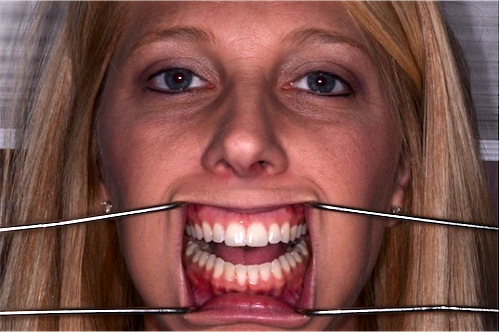Would you like to make your communication with your lab more predictable? When it comes to increasing predictability, communication with our lab is the first and most critical step in achieving excellent results. No matter how good you and your lab technician are it's difficult to be perfect all the time. While it should be rare, adjustments and remakes are going to happen to all of us. Our best option is to do everything we can to increase the predictability of getting an outstanding result every time.
As the saying goes, a picture is worth a thousand words. The right photographs are the best way to communicate color, texture and the relation of the patient's teeth to their face.


When it comes to shade and texture, one of the most important things we have to manage is how the flash reflects off the teeth and shade tab. Typically I will take several shots not only from straight on but also from above, below, the left and the right. The purpose of this is to get the flash to interact with the teeth and shade tab differently on each shot. It's worth noting that the off angle shots are particularly important because in these shots the flash is being bounced off the teeth and away from the camera lens and gives the lab more information than a straight on shot, which will typically have much more flash reflection.
Additionally when it comes to shade photographs it is critical that you have at least one shade tab in each photograph and that the tab or tabs be held the same distance from the lens and flash as the teeth.

Beyond shade and texture it is equally important to capture the relation of our patient's teeth to their face. For this I like to send a full face and close-up smile and repose shots, along with a photo of lips retracted teeth apart and a photo with the patient's eyes in it as pictured here.

If you are already taking the photos above and are looking for even more ways to increase your predictability through photography, my two suggestions would be to consider the use of a filter such as Polar eyes to remove all the reflections from your images and the use of an alternate flash or flashes.
While a ring flash is the most often used flash in dentistry it can be advantageous to use an alternate flash such as a dual point with bouncers for some of your images.
John R. Carson, DDS, PC, Spear Visiting Faculty and Contributing Author [ www.johncarsondds.com ]
As the saying goes, a picture is worth a thousand words. The right photographs are the best way to communicate color, texture and the relation of the patient's teeth to their face.


When it comes to shade and texture, one of the most important things we have to manage is how the flash reflects off the teeth and shade tab. Typically I will take several shots not only from straight on but also from above, below, the left and the right. The purpose of this is to get the flash to interact with the teeth and shade tab differently on each shot. It's worth noting that the off angle shots are particularly important because in these shots the flash is being bounced off the teeth and away from the camera lens and gives the lab more information than a straight on shot, which will typically have much more flash reflection.
Additionally when it comes to shade photographs it is critical that you have at least one shade tab in each photograph and that the tab or tabs be held the same distance from the lens and flash as the teeth.

Beyond shade and texture it is equally important to capture the relation of our patient's teeth to their face. For this I like to send a full face and close-up smile and repose shots, along with a photo of lips retracted teeth apart and a photo with the patient's eyes in it as pictured here.

If you are already taking the photos above and are looking for even more ways to increase your predictability through photography, my two suggestions would be to consider the use of a filter such as Polar eyes to remove all the reflections from your images and the use of an alternate flash or flashes.
While a ring flash is the most often used flash in dentistry it can be advantageous to use an alternate flash such as a dual point with bouncers for some of your images.
John R. Carson, DDS, PC, Spear Visiting Faculty and Contributing Author [ www.johncarsondds.com ]